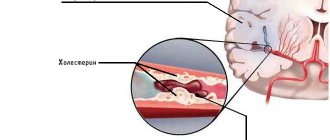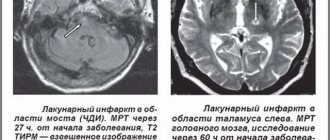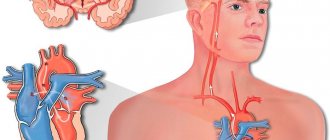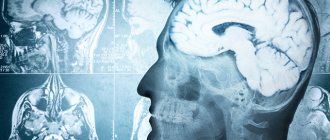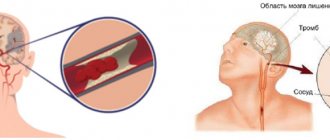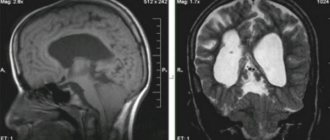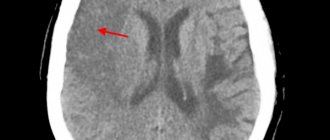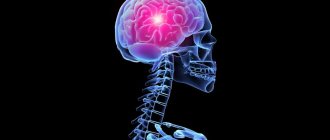Cerebral infarction or ischemic stroke are both names for a stroke caused by a blockage of a blood vessel in a person's brain.
This is the most common type of stroke among Russians, Ukrainians and Belarusians. A blood clot or fatty plaque forms in the patient's brain and blocks a blood vessel - an embolus.
This is focal necrosis of the brain caused by complete and prolonged ischemia, which affects all tissue elements, neurons, glia and blood vessels.
Ischemic infarctions cause focal neurological deficits in the patient. With embolic infarctions they appear abruptly. In atherothrombotic infarctions, they develop over a period of time, usually several hours. Atherothrombotic infarctions are often preceded by transient ischemic attacks (TIAs).
A TIA is a focal neurological deficit that lasts less than 24 hours and resolves.
Symptoms of cerebral infarction
Symptoms of a cerebral infarction depend on where the lesion is located.
However, general symptoms of this pathological process can be identified, including:
- Headache;
- Loss of consciousness, sometimes coma may develop;
- Dizziness;
- Disturbances in the functioning of the pelvic organs;
- Pain in the eyeballs;
- Feeling hot;
- Dry mouth;
- Nausea and vomiting accompanied by severe headache;
- Convulsions (not always present).
If the focus of a cerebral infarction is localized in the right hemisphere, then the following clinical picture is characteristic:
- Complete immobility (hemiparesis) or significant decrease in strength (hemiplegia) of the left limbs;
- Sensitivity in the left half of the body and face disappears or sharply decreases;
- Speech impairment will be observed in left-handed people. In right-handed people, speech disorders develop exclusively when the left hemisphere is damaged. The patient cannot reproduce words, but conscious gestures and facial expressions are preserved;
- The face becomes asymmetrical: the left corner of the mouth goes down, the nasolabial fold is smoothed out.
Depending on which half of the brain is damaged, symptoms of a cerebral infarction will be observed on the opposite side. That is, if the lesion is located in the left hemisphere, then the right half of the body will suffer.
If a cerebral infarction develops in the vertebrobasilar vascular system, then the patient’s symptoms are as follows:
- Dizziness that increases when you tilt your head back;
- Coordination suffers, static disorders are observed;
- There are disturbances in the movement of the eyeballs, vision deteriorates;
- A person pronounces individual letters with difficulty;
- Problems with swallowing food appear;
- Speech becomes quiet, hoarseness appears in the voice;
- Paralysis, paresis, and loss of sensation in the limbs will be observed on the side opposite to the lesion.
It is worth considering separately the symptoms of cerebral infarction depending on which cerebral artery is damaged:
- Anterior cerebral artery – incomplete paralysis of the legs, the occurrence of grasping reflexes, impaired eye movements, motor aphasia;
- Middle cerebral artery – incomplete paralysis and sensitivity disorder of the hands, as well as the lower half of the face, sensory and motor aphasia, laterofixation of the head;
- Posterior cerebral artery – visual disturbances, the patient understands the speech of another person, can speak himself, but he forgets most words.
In severe cases, consciousness is depressed and the person falls into a coma, which can occur when any part of the brain is damaged.
Causes of cerebral infarction
The following causes of cerebral infarction are distinguished:
- Atherosclerosis. It develops in men earlier than in women, since at a young age female blood vessels are protected from atherosclerotic lesions by sex hormones. The coronary arteries are the first to be affected, then the carotid ones, and subsequently the cerebral blood supply system;
- Hypertension. Mild hypertension (pressure up to 150/100 mm Hg), which is the most dangerous, enhances atherosclerosis and disrupts the adaptive reactions of the arteries;
- Heart diseases. Thus, people who have had a myocardial infarction have a high risk of developing a cerebral infarction. In 8% of patients after myocardial infarction, ischemic stroke will develop within the first month, and in 25% of patients - within six months. Coronary heart disease and heart failure are also dangerous;
- High blood viscosity;
- Atrial fibrillation. They cause blood clots to form in the left atrial appendage, which are subsequently transported to the brain;
- Disorders of the endocrine system, primarily diabetes mellitus;
- Vascular diseases (pathologies of their development, Takayasu's disease, anemia, leukemia, malignant tumors).
In addition, do not forget about risk factors that increase the likelihood of a cerebral infarction, including:
- Age (every ten years of life increases the risk of developing cerebral infarction by 5-8 times);
- Hereditary predisposition;
- Physical inactivity;
- Excess weight;
- Smoking (if this bad habit is supplemented by taking oral contraceptives, then smoking becomes a leading risk factor for the development of cerebral infarction);
- Alcohol abuse;
- Acute stress or prolonged psycho-emotional stress.
Prevention
Knowing your risk factors for stroke, following the advice of highly trained professionals, an annual comprehensive body check-up and a healthy lifestyle are the best steps you can take to prevent stroke. If you have had a stroke or transient ischemic attack (TIA), these steps may help prevent another stroke.
The help you receive in the clinic plays a significant role in stopping the acute period of a cerebral infarction.
The risk factors for possible complications after an attack will depend on how qualified and prompt assistance a team of neurologists, cardiologists, neurosurgeons, rehabilitation therapists and physiotherapists will provide you.
Many stroke prevention protocols are the same as cardiovascular disease prevention protocols. Basic recommendations for a healthy lifestyle include:
- Constant blood pressure monitoring. This is one of the most important things you can do to reduce your risk of stroke. If a patient has already had a stroke, lowering blood pressure may help prevent a subsequent TIA or stroke.
- Exercise, manage stress, maintain a healthy weight, and limit sodium, alcohol, and tobacco. In addition to recommending lifestyle changes, our doctor may prescribe medications to treat high blood pressure, as well as a vitamin and mineral supplement and fish oil.
- Reduce the amount of cholesterol and saturated fat in your diet. Eating less cholesterol and fat, especially saturated fat and trans fat, can reduce plaque in the arteries.
- Quitting tobacco use. Smoking increases the risk of stroke for smokers and nonsmokers exposed to secondhand smoke. Quitting tobacco use reduces the risk of stroke.
- Diabetes control.
- Maintaining a healthy weight. Excess weight contributes to the development of other risk factors for stroke, such as high blood pressure, heart disease and diabetes.
- A diet rich in fruits and vegetables. A diet containing five or more daily servings of fruits or vegetables may reduce the risk of stroke.
- Exercise can lower blood pressure. It will also help you lose weight, control diabetes and reduce stress.
Consequences of cerebral infarction
The consequences of a cerebral infarction can be very serious and often pose a direct threat to human life, among them are:
- Brain swelling. It is this complication that develops more often than others and is the most common cause of death of a patient in the first week after an ischemic stroke;
- Congestive pneumonia is the result of the patient being in a horizontal position for a long time. It most often develops 3-4 weeks after a cerebral infarction;
- Pulmonary embolism;
- Acute heart failure;
- Bedsores due to the patient lying motionless in bed for a long time.
In addition to the listed consequences of cerebral infarction, which develop in the early stages, long-term complications can also be identified, including:
- Impaired motor function of the limbs;
- Decreased sensation in the arms, legs and face;
- Speech problems;
- Deterioration of mental abilities;
- Mental disorders;
- Difficulty swallowing food;
- Coordination problems when walking and turning;
- Epileptic seizures (up to 10% of people who have had a cerebral infarction are susceptible to them);
- Malfunctions of the pelvic organs (bladder, kidneys, intestines, reproductive organs suffer).
Course of the disease
Cerebral infarction most often occurs in older people. Before an ischemic cerebral infarction, patients do not always complain of surges in blood pressure or any pronounced symptoms of trouble in the functioning of the blood vessels of the brain. Ischemic cerebral infarction occurs in people with normal blood pressure after nervous stress or heavy physical activity. Depending on the volume of the affected area and its location, brain function is restored. If the affected area is large and vital centers are affected, the patient may lose speech, and the consequences in the form of paralysis, tremors and other disorders of the nervous system will last a lifetime. Most often, the prognosis after an ischemic stroke (cerebral infarction) is favorable - patients recover within a few weeks, can live a long life, work, and take full care of themselves.
Hemorrhagic stroke is acute; about 70% of patients receive surgical treatment - low-traumatic puncture operations are performed to remove brain hematomas. The severity of the patient's condition depends on the location of the hemorrhage and the degree of vascular damage.
Highly qualified medical staff provide effective treatment and good care for patients after heart attack and stroke. Rehabilitation of patients takes place using high-quality European equipment - patients are helped to restore social skills with the help of exercise machines and special equipment, blood circulation in tissues is improved with the help of massage, psychologists and speech therapists work with patients after a stroke. For seriously ill patients after an ischemic or hemorrhagic stroke, the Yusupov Hospital operates a rehabilitation department. You can make an appointment with a neurologist by phone.
What is the difference between a cerebral infarction and a stroke?
When a cerebral infarction occurs, the blood supply to the brain is disrupted, as a result of which the tissues of the affected area begin to die. Insufficient blood flow to the brain occurs due to atherosclerotic plaques that prevent its normal flow, due to heart rhythm disturbances, or due to problems with the blood coagulation system.
With a hemorrhagic stroke of the brain, on the contrary, the blood flow to it increases, which causes an artery rupture. The cause is vascular pathologies or hypertensive crisis.
There are differences in the course of the disease. Thus, cerebral infarction develops gradually, over several hours or even days, and hemorrhagic stroke occurs almost instantly.
Symptoms of diseases
Ischemic stroke is characterized by dizziness, dark vision, numbness in the limbs - a feeling of numbness appears in the arm or leg, in some cases symptoms appear on one half of the body. The patient's speech becomes incoherent or he cannot speak at all for some time. The face and lips may become distorted - facial paralysis develops. This occurs due to damage to a part of the brain and its failure to perform its functions. With timely assistance, functionality is restored - healthy areas of the brain begin to be responsible for speech, muscle function and other functions.
Hemorrhagic stroke is characterized by an acute course of the disease, the appearance of the following symptoms:
- a sharp decrease in visual acuity;
- loss of consciousness;
- photophobia;
- tinnitus;
- headache;
- vomiting, severe nausea;
- redness of the face and body;
- unsteady gait;
- convulsions;
- paralysis of one side of the face;
- paralysis of one side of the body;
- impaired coordination of movements;
- the patient speaks poorly, gets confused in words;
- coma.
It is very important to provide first aid for a brain stroke as early as possible. The patient is admitted to the hospital, diagnostics are carried out, seizures are eliminated, brain swelling is relieved, and the patient’s condition is stabilized. On the basis of the Yusupov Hospital there is a hospital, an intensive care unit, and a rehabilitation unit for patients after serious illnesses. If necessary, resuscitation measures will be carried out at the Yusupov Hospital and the seriously ill patient will be cared for.
